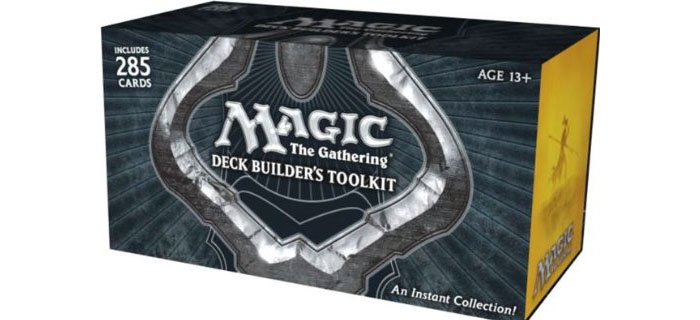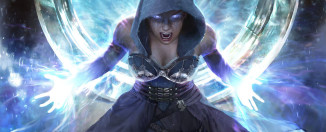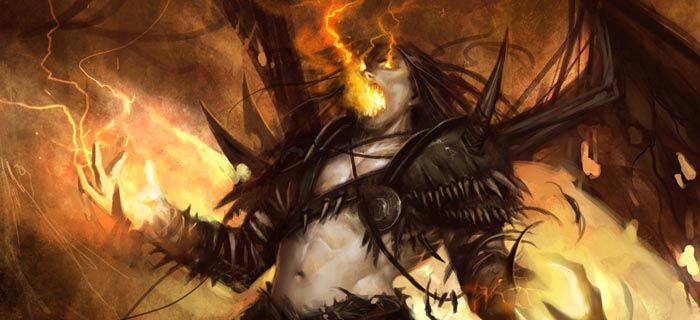Playing paper Magic: How to (slightly) not suck at Draft
Magic is an amazing game, it truly is. However, it’s all too easy to contend yourself with simply playing Duels of the Planeswalkers and/or watching coverage from WingspanTT, your fourth favorite commenter on YouTube. Yet the true game lies out there, with cards that you can touch, play, and even eat! (Don’t eat them.)
Why aren’t you playing paper? “It’s too expensive,” you may say. Other excuses include: “There’s no players in my area.” or my favorite, “I’m too bad and would only waste money.”
Wrong.
What is your name?
Magic happens every Friday night, in each participating comic shop. Believe me, a lot of shops participate, even if you don’t happen to live in a city on the east coast area of the United States. (That seems to be the only area where anything else applies.) You can use the Store Locator to find one close to you.
Financially, a weekly Friday Night Magic will hardly set you back. You only have to “buy” three boosters to participate in a Draft. It’s not necessary yet highly advised that you also invest into some (100 should keep you safe for most applications) sleeves, a few dice (one of which should be 20-sided)*, and some way to carry your cards gently. Even a simple plastic deck box can do the job, which is great since they’re dirt cheap. This might sound like a lot of initial investment, but you’ll be ready to go with about $30 invested, with $15 of those going towards boosters. Best thing is, any comic shop worth your time will have plenty of everything on stock.
And, finally, the most common argument. First, don’t panic. No one can take your cards from you. You will always get at least your money’s worth. Then, about the “I can’t possibly win” business. Let me tell you about a friend whom I dragged to FNM; His experience with Magic includes, and consists fully of, a few hours with Duels of the Planeswalkers 2014. So far, he has always placed in the top two thirds. Magic’s skill curve reaches a huge flat very early on, making it easy to do at least decently. Even if you don’t, you will still get what you paid.
It seems like a romantic myth, but it’s actually true: People go to FNM to have fun and not all of them play Magic for a living. Even if you’re a bit below the flat of non-terribleness, people will be friendly and glad to answer a question or two. If you forgot a trigger or don’t know a rules interaction**, so fucking what? It’s casual Magic, you won’t get a lifetime ban on life for it. Speaking from personal experience, there’s often also somebody – perhaps your match opponent herself – whom you can ask to look into your deck and tell you why Vanquish the Foul is horrible. Now for taking you above the terrible flat of non-terribleness.
What is your quest?
First and most importantly, something you just need to do when transitioning to paper from electronic: Shuffle your cards well. You can only win with a well-shuffled deck since mana doesn’t automatically trickle in each turn. My personal favorite method is to divide the lands in half, alternating between each colour if I’m using more than one, and put one pile on top of the deck and one on the bottom. Then do a pile shuffle, which is to divide your deck into some piles (I found eight to be a helpful number since it also allows you to check if you have exactly 40 cards) by taking the top card of your deck and moving on to the next pile, then putting the piles together randomly. At this point, your deck can be considered stacked, so follow it up with your favorite methods of shuffling. You have plenty of time before playing each game, so make sure you shuffle well. No, really, I’m talking no less than one or two minutes for the first shuffle after building and thirty seconds for each consequent shuffle.*** However, for the love of Elspeth, don’t riffle, ever.
No matter how tempting it may be to cut down just one measly land out of your deck, the go-to ratio of lands in your deck should be 40% aka 17. Since decks are only 40 cards big in limited, even a single land more or less can make a drastic difference. You can go down to 16 if your mana curve is heavily low-focused and/or you run fetchers like Rampant Growth or Traveler’s Amulet, or up to 18 if you’re going hyper control with lots of lategame bombs. However, stick to 17 unless you can tell from half a mile away that you should use another ratio. It’s better to play it safe and perhaps suffer from it some rather than outright lose because you played too risky. Remember, there’s no free mulligan in most settings besides Duels of the Planeswalkers, so don’t test your luck.
“How do I know how my mana curve is?” ask you. Well, it can be a bit tricky, but it usually comes down to being somewhere in these three archetypes (all of which are viable in Theros). If you haven’t already, you should play Duels of the Planeswalkers (Magic 2014). It contains a few good examples of each bigger deck archetype preconstructed, so study them and learn why they do what they do. Full deck guides for most DotP decks can be found here on TopTierTactics, including analysis. While you’re still picking, look at your deck and ask yourself what you want to achieve with it, then choose cards accordingly.
- Aggro: These decks contain a lot of low-cost creatures and intend to just zerg your opponent down before she’s ready without much of a backup plan besides “Smash face harder”. Avacyn’s Glory in DotP14 is a decent example of this, but so is Sword of the Samurai. Vulnerable to mass removal and card disadvantage, but powerful regardless. In Theros, Minotaurs can fulfill this type very well.
- Midrange: What you first imagine when you think about Magic, and what you should be playing most of the time. This type of deck is the strongest (and heaviest) between four and six mana, but it is versatile all throughout. Easiest to build, too, since you’re guaranteed to get some mix of decent cards across the mana range. DotP14’s Hunter’s Strength or Guardians of Light are good examples of this type. If you’ve ever seen an intro deck, basically that.
- Control: Focuses on the late game with a higher concentration of high-cost bombs as well as removal and tempo-slowing cards that ensure you’ll be alive to play them. Don’t confuse lifegain for control; Control focuses on preventing your opponent from winning rather than just trying not to lose immediately. Masks of the Dimir is the prime showcase of this strategy.
No matter your type, the amount of cards that cost a set amount of mana, plotted against mana costs, should draw out as a flattened Bell curve. In other words, don’t flood your deck with low-cost weenies that will be useless in the late game, but don’t leave home without them either. Same goes for higher-cost bombs too. (Note that I use these words carefully – for aggro, five mana can be bomb cost.)
Also, there is a sideboard. In Limited, your sideboard consists of all cards you pulled during the same event. Leave too specific cards like Dark Betrayal out of the deck until you know what your opponent will be playing, then take them in if necessary. Even if you don’t have such specific cards, still take the chance to sideboard. Does your opponent have a lot of X/1 creatures giving you trouble? Time to take in those Spark Jolts you pulled! And so on.
What is your favorite colour?
The toughest choice during a Draft often comes right at the start: Choosing what colour(s) and strategy to play. Generally speaking, you often want to play two colours in Limited, such as not to artificially strain your card choice. Most of the time, two-colour combinations run without mana fixing, so just keep in mind during deckbuilding that your lands will be about equally split between both colours and you should be fine. While the argument that rarer cards are better than more common ones is bogus, what rares you pulled can be a good help in deciding what you want to play. For instance, if you got your hands on a Planeswalker, then you are playing that colour combination, come what may.
Sensei Wing says: In Theros, the devotion mechanic also allows for very viable monocoloured decks if you pulled some decent devoted. (Like the respective god.) Also, it’s okay to change colour if you’re still in the first pack or very early in the second one. You will only use half the cards you pick, so not every one needs to be perfect.
Besides that, don’t forget that there are other people. If you’re in a pinch between two really decent cards, pick the rarer one. The more common is more likely to be passed all the way back to you, or show up in another booster. Keep mental count so that you know which cards you’ve seen before. One more point, if you don’t desperately need anything from a booster, consider taking what you don’t want to see played against you. For instance, if you’re playing Red/Black aggro and open a Hundred-Handed One in your third booster, take it unless there’s a very good argument speaking against it. Though he won’t help you, neither will he help your opponents.
*Yes, you can literally take any old six-sided dice that you find lying around the house; Their use will be mostly for counters, where I’ve found three to be enough for most situations. You will often find what you need for sale (or occasionally for free) right in the shop. If not, ask around. It’s quite likely that your opponent will have a few spare dice that you can use during the match.
**If you’re not the most experienced with Magic, check out Judge’s Corner. If you are, why not discuss in the comments down below what happens if Opalescence and Humility enter the battlefield simultaneously as part of the resolution of a Hypergenesis?
***Also part of why you should use sleeves. You’ll be shuffling more than you might expect, so make sure it’s easier for you and that you won’t damage any valuable cards in the process. Yes, their sometimes sharp edges hurt a bit while shuffling at first, but you’ll get used to the pain. Also, obviously shuffle within reason. Only the first shuffling session really serves to distribute cards across your library. If you use something like Traveler’s Amulet, you shuffle only so that you don’t know your library’s order, so do a few quick passes and keep the game running.







Well humility and Opalesence will actually enter the battlefield in a sequential order instead of simultaniously. :) The first one will affect the 2nd one and so forth.